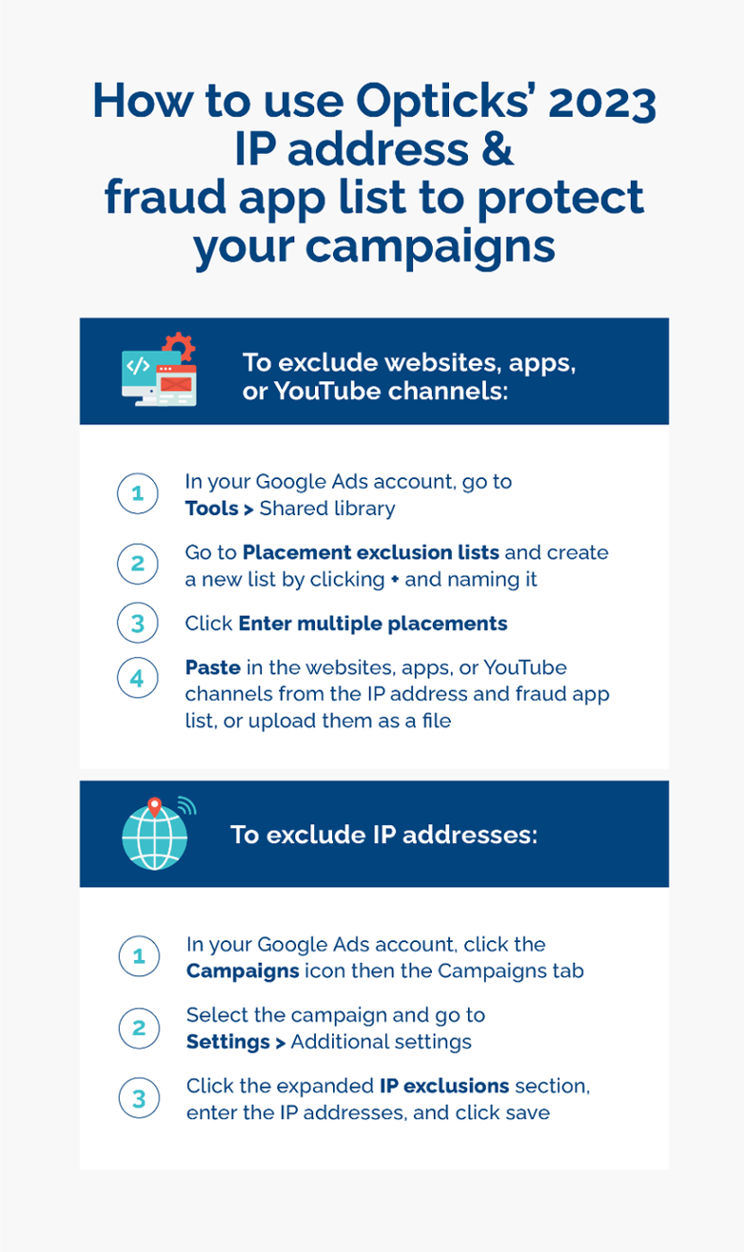Are you — like many other advertisers and marketers — struggling with the weight of manually reviewing websites for ad placements and double-checking potentially fraudulent audiences through IPs?
Displaying your ads on the right websites and apps for your target audience is a key aspect, as is making sure your campaigns are clicked on by human audiences and not automated bots.
But how do you know which placements, on both sites and apps, and Internet Protocol (IP) addresses to avoid? Well, you’re in luck! The team at Opticks has analyzed thousands of placements, apps, and IP addresses to put together the exhaustive 2023 IP address and ad fraud app list to help you exclude them from your ad placements.
What are fraudulent apps and IP addresses?
Fraudulent apps are used to generate bot traffic or false engagement with websites and other apps and are often designed to automatically click on ads or generate fake impressions.
Fraudulent IP addresses are used to mask the location of a user or device to fake traffic, clicks, and leads and make them more valuable than they actually are.
Both fraudulent IP addresses and apps can also be used to facilitate bot traffic, by masking the true location and identity of the bots.
The impact of fraudulent apps and IP addresses
Does it matter if you place your ads on fraudulent apps and IP addresses? The short answer is yes. Not only do you risk skewing your campaign data and suffering adverse effects on your campaign performance, but you’ll almost certainly be wasting precious ad spend on fraudulent leads and clicks.
Bottom line: Identifying and blocking fraudulent IP addresses and apps is essential to maintaining campaign security, preventing fraud, and protecting your budget.
The 2023 IP address and ad fraud app list
Fortunately, with Google’s Placement Exclusion Tool, you can prevent your ads from being displayed on certain apps and websites, empowering you to only allow ads to be placed on safe, desirable, and relevant websites and apps.
To help you get started, the Opticks team analyzed countless apps and websites to produce the 2023 IP address and ad fraud app list, a spreadsheet that contains the following Google Ads filtered data:
- The top 200 placements that received more than 10% bot traffic (identified by Opticks) in the last 3 months.
- The top 500 IP addresses and their respective countries that received bot traffic (identified by Opticks) in the last 3 months.
How to use Opticks’ 2023 IP address and fraud app list to protect your campaigns

Using this list to protect your campaigns couldn’t be easier — just follow the simple steps below to begin excluding fraudulent apps, IP addresses, and even YouTube channels from potential ad placement options.
How to use the list to exclude websites, apps, or YouTube channels
- Sign in to your Google Ads account as a manager, click the tools icon, head to the “Shared library” tab, and click on “Placement exclusion lists”.
- Create a new list by clicking the + symbol and giving the list a name. Then click the “Enter multiple placements” link at the bottom.
- From here, you can either manually paste in the websites, apps, or YouTube channels from the IP address and fraud app list, or upload them as a file.
How to use the list to exclude IP addresses
- In your Google Ads account, click the Campaigns icon and head to the Campaigns tab.
- Select the campaign from which you’d like to exclude IP addresses, click the settings icon, and select “Additional settings”.
- Click the expanded “IP exclusions” section, enter the IP addresses, and click save.
NOTE:
- While you can copy placements and IPs and blacklist them in your campaigns and ad groups, you’ll need to check which types of campaigns allow for certain types of exclusions. For example, Performance Max or Shopping campaigns do not allow IP blacklisting.
- IP exclusions aren’t available for video campaigns, hotel campaigns, App campaigns, Smart Display campaigns, and Discovery campaigns.
Best practices for preventing Google Ads ad fraud
Manually creating and adding exclusion lists to their Google Ads accounts to combat fraudulent IP addresses and apps is a start, but advertisers must use a combination of tools and strategies to help reduce the risk of ad fraud, including:
- Monitoring ad performance closely and regularly to identify anomalies, suspicious sources, and fraud indicators.
- Working only with trusted and verified partners to take advantage of the fraud detection and prevention mechanisms they have in place and reach quality audiences.
- Implementing robust fraud detection software that uses advanced algorithms and machine learning techniques to identify, mitigate, and prevent fraudulent activities in real time.
There’s only one way to fully protect your campaigns from fraudulent IPs and ad fraud
Protecting campaigns from any and all fraudulent activity is critical for maintaining campaign performance and minimizing financial losses.
IP address and app fraud lists can only get you so far. Fraudsters are quick off the mark and can create new publisher sites or apps to defraud your ad campaigns at the drop of a hat — meaning that you’re still at risk.
Opticks is the most efficient way to prevent fraudulent IPs and apps from damaging your campaigns. It uses automatic fraud prevention and up-to-date, maintained exclusion lists to keep your campaigns safe.
To find out more about how we can work together to prevent fraudulent placements from destroying your ad campaigns, contact us or click here to start your free trial.
